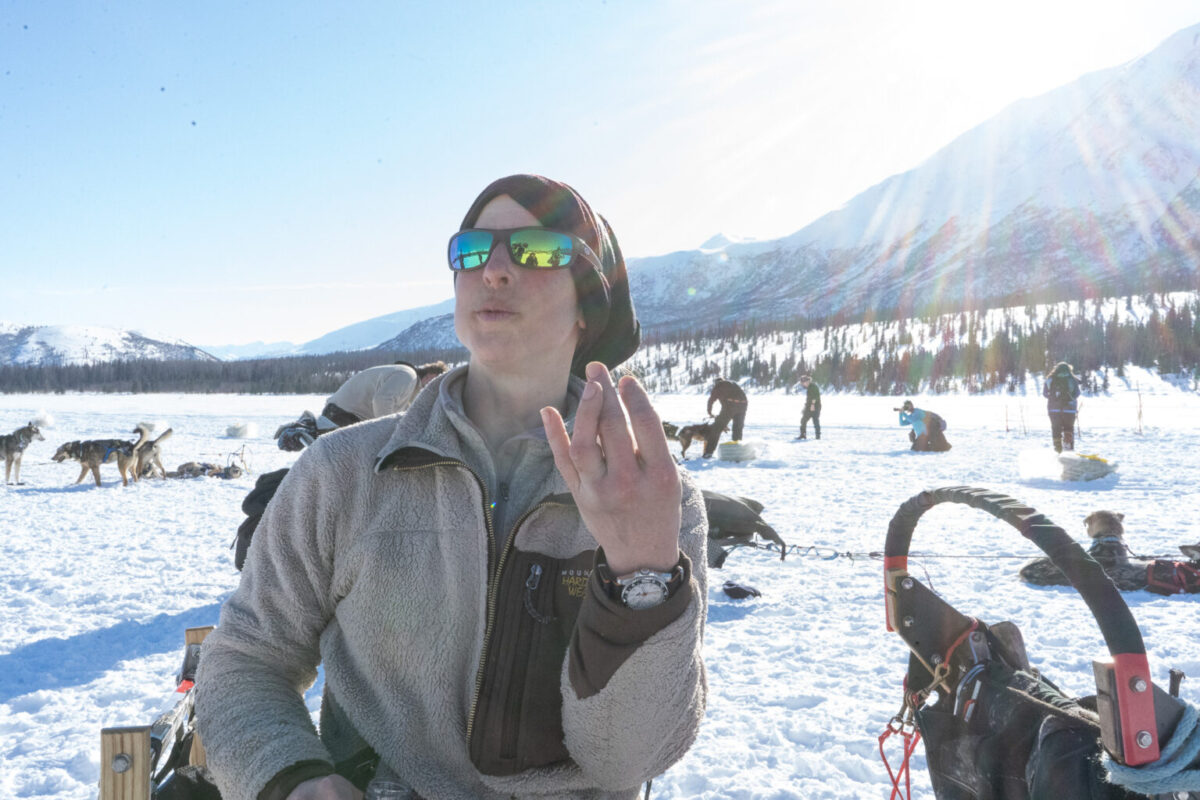This article by Lex Treinen was originally published by Alaska Public Media. It was republished with permission through a partnership with KNOM.
Rookie Eddie Burke Jr. wiped sweat from his brow Monday as he filled bowls of water for his team at the checkpoint here, about 150 miles into the 1,000 mile Iditarod Trail Sled Dog Race. He wore just a thin cotton hoodie and snow pants but said it was plenty.
“I’m feeling hot, but I’m feeling good, and the dogs are feeling good,” he said.
Most sled dogs prefer racing in below-zero temperatures, and the 40 degrees and intense sun Monday afternoon — hot by Alaska winter standards — prompted many teams to stop and rest here through the heat of the day. The water source — a hole cut through Puntilla Lake near the dog yard — was busy with mushers throughout the afternoon as they made sure their dogs stayed hydrated. Out-of-state tourists flew to the lodge on private charters, and gathered around to snap photos.
Riley Dyche said the dogs like the sun, just not running in it.
“They’re pretty much enjoying just sunbathing,” he said. “As you can see they’re all splayed out, conked, I’m not gonna put straw out for awhile, if I do at all.”
For his part, Dyche was overdressed for the warmer weather after a cold morning on the sled.
“Three base layers, then two Norwegian sweaters, and then a puffy mid-layer and then my parka that I actually just made for myself,” he said as he tore off one of his sweaters.
Nearby, veteran Dan Kaduce was also dishing out water for his dogs. The musher trains out of Chatanika in Interior Alaska, where temperatures rarely get above zero.
“Definitely our hottest day of the year so far,” he said.
His dark-furred dogs were especially affected by the sun. Despite being a top contender after finishing in fourth last year, Kaduce said he was taking his time to wait out the sun.

Not everyone was adapting their schedules to the temperatures though.
Ryan Redington was the first musher into Rainy Pass, arriving around 9:30 a.m., within five minutes of his time last year. After a short nap in the checkpoint, he was back out in the dog yard to give his team some more water. He said he was going for consistency with his run-rest schedule, even if it meant he’d be starting a run during the warmest part of the day.
“I wanna get ’em on a good run-rest schedule where the dogs know they’re gonna rest a good amount,” he said. “We’ve still got a long ways to Nome.”
Several other top mushers chose to blow through the checkpoint and camp later down the trail, including Jessie Holmes, Richie Diehl, Kelly Maixner and reigning champ Brent Sass.
Sass stayed for just four minutes at Rainy Pass to grab things from the bags of gear and food that mushers ship to checkpoints ahead of time. From here, teams head toward the notoriously steep and windy Dalzell Gorge. Sass said he was still feeling calm despite the pressure to repeat his win from last year.
“We’re basically doing the same schedule as last year, so yeah, having a blast,” he said.

Sass is running the same rest schedule, but he was in fact about an hour faster than last year getting into Rainy Pass.
While Sass had the confidence to cruise comfortably through the early section of trail, it was by no means easy, as rookie Jennifer LaBar found out. Coming down a series of steep downhills, known as the Happy River Steps, she ran into trouble at a sharp corner. She said she didn’t step on her foot brake soon enough.
“By the time I hit it, it kinda hit the bank on the right side and then kinda bombed across the trail to the left,” she said
She held onto the sled handlebars, but her finger got sandwiched between the handlebars and the snow bank.
At the checkpoint, her left ring finger was still bent out of place, and she was forced to do her dog chores — like laying out straw and preparing food — with just one hand. She said there were doctors here who would have a look at her finger, and hopefully put it back into place. Still, she had a smile on her face.

“I’m here and it’s beautiful and I’m just trying to be hopeful,” she said.
She said if she can’t get to Nome this year, she’ll try again next year.
Several hours later, around 9:30 p.m., the Iditarod announced that LaBar had called it quits in Rainy Pass due to injury. She’s the first musher to scratch from this year’s race.
Image at top: Eddie Burke Jr. dishes out water on Monday for his dogs at the Iditarod checkpoint near Rainy Pass Lodge. (Lex Treinen/Alaska Public Media)





